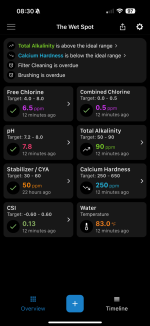- Jul 17, 2019
- 4,069
- Pool Size
- 13000
- Surface
- Plaster
- Chlorine
- Salt Water Generator
- SWG Type
- Pentair Intellichlor IC-40
Sounds like a plan. Just make sure you give yourself some wiggle room for when you need to use the pucks (like 1-2 week vacations, etc.).I am understanding more every day, so thanks for the replies. My plan of action for now is to continue testing and logging daily, keeping a single puck in the chlorinator and maintaining my FC at recommended levels using LC. I will test CYA biweekly. If my PH or TA increases to 8.0 or 100, I will perform an MA treatment.





